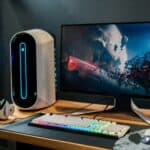Dealing with Ethernet connection problems can be frustrating, especially when you need a reliable internet connection for work or entertainment. When your Ethernet suddenly stops working, the issue could stem from several sources including loose cables, port damage, driver issues, or router problems. The most common fixes include checking that your Ethernet cable is securely connected at both ends, examining the cable for damage, updating network drivers, and testing different ports on your router.
These connection issues often appear without warning, leaving users confused about why their previously stable connection has failed. Before rushing to replace equipment or call technical support, it’s worth trying some simple troubleshooting steps. Many Ethernet problems can be resolved with basic checks and updates that take just minutes to complete.
Here are the steps to troubleshoot why your Ethernet is not working:
Why Is My Ethernet Not Working: Troubleshooting Guide
1. Check Physical Connections
- Make sure the Ethernet cable is securely plugged in to both your computer and your router or modem.
- Try using a different Ethernet port on your router or switch.
- Test the Ethernet cable with another device to confirm it’s not damaged.
2. Restart Your Devices
- Power off your computer, modem, and router.
- Wait for about 30 seconds.
- Turn on the modem first, then the router, and finally your computer.
3. Inspect the Ethernet Cable
- Check for visible damage (bent pins, frayed ends, cuts).
- Try using a different Ethernet cable to rule out a cable issue.
4. Check Network Settings (Windows)
- Go to Settings > Network & Internet > Ethernet.
- Make sure it says “Connected”.
- If not, click “Change adapter options”, right-click your Ethernet connection, and select “Enable” if it’s disabled.
5. Check Network Settings (macOS)
- Go to System Settings > Network.
- Select Ethernet and check if it shows as connected.
- If not, try clicking Renew DHCP Lease or Use DHCP under advanced settings.
6. Update Network Drivers
- On Windows:
- Open Device Manager.
- Expand Network Adapters.
- Right-click your Ethernet adapter and choose Update driver.
- On Mac, make sure you’ve installed the latest system updates.
7. Disable and Re-enable the Ethernet Adapter
- In Device Manager (Windows), right-click the Ethernet adapter and choose Disable.
- Wait a few seconds, then right-click again and choose Enable.
8. Check IP Configuration
- Open Command Prompt (Windows) and type:
ipconfig /all- Make sure the Ethernet adapter has a valid IP address (not starting with 169.x.x.x).
- If not, type:
ipconfig /release ipconfig /renew
9. Turn Off VPN or Security Software
- VPNs or firewall software can sometimes block Ethernet access.
- Temporarily disable them to see if Ethernet starts working.
10. Test With Another Device
- Connect another device using the same Ethernet port and cable.
- If it works, the issue is with your original computer.
- If not, the issue may be with the router, switch, or network configuration.
11. Reset Network Settings
- On Windows:
- Go to Settings > Network & Internet > Status > Network reset.
- On Mac:
- Delete and re-add the Ethernet service in System Settings > Network.
12. Check Router or Modem Settings
- Log into your router and make sure Ethernet ports are enabled.
- Update your router’s firmware if needed.
- Some routers allow you to disable LAN ports, so check port status.
If none of these steps work, the Ethernet port on your computer or router might be damaged. In that case, try using a USB to Ethernet adapter or contact a technician.
Key Takeaways
- Check physical connections first by ensuring cables are properly plugged in and examining them for damage.
- Update or reinstall network adapter drivers through Device Manager if cable connections appear fine.
- Try different Ethernet ports on your router and restart both your computer and router if problems persist.
Understanding Ethernet Connections
Ethernet connections form the backbone of wired internet access in homes and offices. They provide more reliable and often faster internet speeds than wireless alternatives.
Components of an Ethernet Connection
An Ethernet connection consists of several key parts working together. The most visible component is the Ethernet cable itself, which contains twisted copper wire pairs that transmit data signals between devices.
The cable connects to Ethernet ports found on computers, routers, modems, and other networked devices. These ports resemble oversized telephone jacks and are sometimes labeled as “LAN” ports.
Network interface cards (NICs) are built into most modern computers and handle the communication between your device and the network. When functioning properly, small lights near the Ethernet port flash to indicate active data transmission.
Routers and switches serve as connection hubs, directing traffic between devices and your modem. The modem connects your home network to your Internet Service Provider’s network.
Difference Between Ethernet and Wi-Fi
Ethernet and Wi-Fi represent two different approaches to network connectivity. Ethernet uses physical cables for direct connections, while Wi-Fi transmits data wirelessly through radio signals.
Ethernet connections typically deliver more consistent speeds without interference issues that can plague Wi-Fi. Wired connections also provide lower latency (delay), making them ideal for online gaming, video conferencing, and large file transfers.
Wi-Fi offers convenience and mobility that Ethernet cannot match. Users can connect from anywhere within the signal range without dealing with cables.
Security represents another difference. Ethernet connections are inherently more secure since they require physical access to the network. Wi-Fi signals can potentially be intercepted if not properly secured with strong encryption.
Common Ethernet Issues and Diagnostics
Ethernet connectivity problems can be frustrating but are often easy to fix. Most issues stem from physical connections, adapter settings, or software configuration problems that can be identified through systematic troubleshooting.
Physical Inspection
The first step in diagnosing Ethernet issues is checking the physical components. Start by examining all cable connections to ensure they’re properly seated in their ports. You should hear a distinct click when an Ethernet cable is fully inserted.
Look for damage on the cable itself, including bent connectors, cuts, or excessive bending. A damaged cable is a common cause of connectivity problems.
Check the status lights on both your network adapter and router/switch. Functioning connections typically show solid or blinking lights. No lights often indicate a hardware problem or disconnection.
Also inspect the ports for dust or debris that might prevent proper connection. A can of compressed air can help clean dirty ports without damaging the components.
Checking Network Adapter Status
Open Device Manager by right-clicking on the Start button and selecting “Device Manager.” Expand the “Network adapters” section to view your Ethernet adapter.
Look for warning symbols (yellow triangles) that indicate driver problems. Right-click on your adapter and select “Properties” to check its status.
If the adapter shows as disabled, right-click and select “Enable device.” For driver issues, select “Update driver” or uninstall and reinstall the driver completely.
Sometimes the adapter needs a reset. Right-click it, select “Disable device,” wait a few seconds, then “Enable device” to restart it fresh.
Windows may also show “No internet” or “Limited connectivity” in the network icon – this helps identify if the issue is with your local connection or internet service provider.
Using Troubleshooting Tools
Windows includes several built-in tools for network diagnostics. Right-click the network icon in the taskbar and select “Troubleshoot problems” to run the network troubleshooter.
Open Command Prompt as administrator and try these commands:
ipconfig /releasefollowed byipconfig /renewto reset your IP addressipconfig /flushdnsto clear DNS cachenetsh winsock resetto reset network settings
The ping command can test connectivity:
ping 127.0.0.1 (tests your network adapter)
ping 192.168.1.1 (tests connection to router)
ping google.com (tests internet connectivity)
System File Checker (sfc /scannow) can repair corrupted Windows files that might affect networking.
Network and Sharing Center
Access Network and Sharing Center through Control Panel or by right-clicking the network icon and selecting “Open Network & Internet settings.”
Check your connection status by clicking on your Ethernet connection name. This shows if data is being sent and received properly.
Click “Change adapter settings” to view all network connections. Right-click your Ethernet adapter to access additional options like disabling/enabling or viewing properties.
In adapter properties, ensure “Internet Protocol Version 4 (TCP/IPv4)” is enabled and properly configured. Most home networks use automatic (DHCP) settings, but incorrect static IP settings can cause connection problems.
The Network Reset option (found in Settings > Network & Internet > Status) can help resolve stubborn network issues by reinstalling all network adapters and returning settings to defaults.
Technical Solutions
When Ethernet connections fail, several technical approaches can solve the problem. These fixes range from updating software to resetting network configurations.
Updating Ethernet Drivers
Outdated or corrupted Ethernet drivers often cause connectivity problems. To update drivers on Windows 10, open Device Manager by right-clicking the Start button and selecting it from the menu.
Expand the “Network adapters” section and locate your Ethernet adapter. Right-click on it and select “Update driver.” Choose to search automatically for updated driver software.
If Device Manager doesn’t find new drivers, check the “Show hidden devices” option under the View menu to reveal disabled adapters. Sometimes, visiting the computer or motherboard manufacturer’s support website provides the latest drivers.
After installation, restart the computer to properly implement the new driver. This refresh often resolves connection issues caused by outdated software.
Renewing DHCP Configuration
DHCP problems can prevent proper IP address assignment, leading to connection failures. Open Command Prompt as administrator by searching “cmd” and right-clicking to run as administrator.
Type these commands in sequence:
ipconfig /release
ipconfig /flushdns
ipconfig /renew
The first command releases current IP settings, the second clears the DNS cache, and the third requests new network configurations from the router.
This process forces your computer to establish a fresh connection with the network. It’s particularly effective when experiencing intermittent connectivity issues or after changing network hardware.
Resetting Network Components
For persistent Ethernet problems, resetting network components can help. Start by power cycling your router—unplug it for 30 seconds before reconnecting.
Next, reset the Windows network stack by opening Command Prompt as administrator and entering:
netsh winsock reset
netsh int ip reset
These commands rebuild essential networking components in the operating system. After executing them, restart your computer to complete the reset process.
Check your BIOS settings if problems persist. During startup, enter BIOS (often by pressing F2, F12, or Delete) and ensure the onboard Ethernet controller is enabled.
For hardware issues, try a different Ethernet cable or port on your router to isolate physical connection problems.
Advanced Support and Product Information
When Ethernet issues persist despite basic troubleshooting, it’s time to explore professional resources and learn about the technology behind your connection. These advanced steps can help resolve complex networking problems.
Seeking Professional Tech Support
Most computer and motherboard manufacturers offer dedicated tech support for networking issues. Dell, MSI, and other companies maintain support websites with troubleshooting tools specifically for Ethernet problems.
For persistent issues, consider contacting your manufacturer’s support line. Many offer remote diagnostics to identify hardware failures or software conflicts affecting your Ethernet connection.
Online communities like Reddit forums or Microsoft Community can provide peer support. The MSI_Gaming subreddit, for example, has helped users resolve specific Ethernet port issues on MSI motherboards through Windows 11 network settings adjustments.
IT professionals can diagnose hardware failures using specialized equipment when software solutions fail.
Exploring Ethernet Products
Modern Ethernet adapters come in various speeds and configurations:
| Ethernet Standard | Speed | Common Use |
|---|---|---|
| Gigabit Ethernet | 1 Gbps | Home/Small Office |
| 2.5G Ethernet | 2.5 Gbps | Gaming/Content Creation |
| 10G Ethernet | 10 Gbps | Enterprise/Servers |
Intel’s Ethernet adapters are widely used for their reliability and performance. Their controllers are often integrated into motherboards with Intel chipsets supporting processors like the Core i9 series.
PCIe Ethernet cards can replace faulty onboard controllers or upgrade connection speeds. These cards range from basic gigabit models to high-end 10G versions for professional use.
Learning About New Technologies
Ethernet technology continues to evolve with faster speeds and better reliability. The latest standards support up to 400 Gbps in enterprise environments, while consumer technology regularly implements 2.5G and 5G speeds.
Intel’s server-focused products like Ice Lake and Emerald Rapids processors include enhanced Ethernet capabilities designed for data centers and high-traffic networks. These technologies eventually influence consumer products.
Power over Ethernet (PoE) allows devices to receive power through Ethernet cables, simplifying installation of IP cameras, phones, and access points.
Smart network switches now offer traffic prioritization and management features that can improve connection stability and performance for sensitive applications like gaming or video conferencing.
Learning about these technologies helps users make informed decisions when upgrading networking equipment.
Frequently Asked Questions
Ethernet connection problems can be frustrating but are often fixable with the right troubleshooting steps. Here are answers to common questions about ethernet connectivity issues.
What steps can I take if my computer is not detecting an Ethernet cable?
First, check that the Ethernet cable is properly connected at both ends. Sometimes cables can become loose or damaged.
Try using a different Ethernet cable to rule out cable damage. Cable wear and tear is a common cause of connection problems.
Restart your computer and check Device Manager for hidden devices. Sometimes the network adapter needs to be reinstalled or updated to function properly.
How can I troubleshoot an Ethernet connection that has no internet access?
Restart your modem and router by unplugging them for 30 seconds before plugging them back in. This simple step resolves many connection issues.
Check if other devices can connect to the internet through the same network. If they can, the problem is likely with your computer.
Run the Windows Network Troubleshooter by right-clicking on the network icon in the taskbar. This built-in tool can identify and fix common problems.
What are the common causes for an Ethernet connection failure on Windows 10?
Outdated or corrupted network drivers often cause Ethernet failures. Updating these drivers through Device Manager can resolve many issues.
Hardware problems with the Ethernet port or network adapter can prevent connections. Inspect the port for visible damage.
Network configuration issues, including IP address conflicts, can also prevent proper connections. Resetting network settings sometimes helps.
Why does my Ethernet connection show as ‘unidentified network’ on Windows 11?
IP configuration issues commonly cause the ‘unidentified network’ error. Running the command ‘ipconfig /release’ followed by ‘ipconfig /renew’ in Command Prompt can help.
Security software or firewalls sometimes block network identification. Temporarily disabling these programs can determine if they’re causing the problem.
Router configuration problems may prevent proper network identification. Checking router settings or performing a router reset might be necessary.
How can I resolve an issue where my Ethernet is not working but Wi-Fi is?
Check if the Ethernet connection is enabled in Network Settings. Sometimes it gets disabled accidentally.
Update or reinstall the Ethernet adapter drivers. Wi-Fi and Ethernet use different drivers, so one can work while the other fails.
Verify the Ethernet port works by testing on another device. Physical damage to the port sometimes causes connection failures while Wi-Fi continues to function.
What should I do if my PlayStation 5 is not connecting to the internet via Ethernet?
Test the Ethernet cable with another device to ensure it works properly. Faulty cables are a common cause of PS5 connection problems.
Restart both the PS5 and your router. Power cycling equipment resolves many temporary connection glitches.
Check the PS5 network settings and try setting up the connection manually. Sometimes automatic configuration fails, and manual setup is needed.







